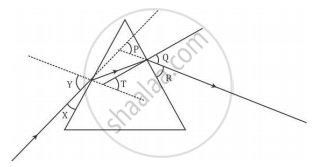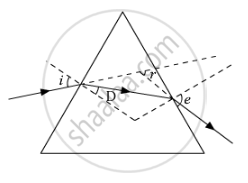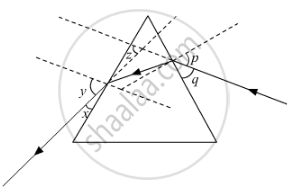Advertisements
Advertisements
प्रश्न
In the following diagram, the correctly marked angles are
(A) All
(B) Only ∠i and ∠A
(C) ∠i, ∠r and ∠A
(D) ∠i, ∠A and ∠D
उत्तर
Angle i by conventions represents the angle of incidence which is formed between the incident ray and the normal. From the given figure it is clear that angle i is correctly marked.
Angle r by convention represents angle of refraction which is formed between the refracted ray and the normal. From the given figure it is clear that angle r is correctly marked.
Angle e by convention represents angle of emergent which is formed between the emergent ray and the normal. But in the given figure it is shown between the emergent ray and the incident ray. Therefore, it is incorrectly marked.
Angle D by conventions represents the angle of deviation which is formed between the emergent ray and the incident ray. But in the given figure it is shown between the emergent ray and the normal. Therefore, it is incorrectly marked.
Angle A represents angle of prism and it is correctly marked.
Hence, the correct answer is option (C).
APPEARS IN
संबंधित प्रश्न
In the following diagram, the path of a ray of light passing through a glass prism is shown:

In this diagram the angle of incidence, the angle of emergence and the angle of deviation respectively are (select the correct option):
(A) X, R and T
(B) Y, Q and T
(C) X, Q and P
(D) Y, Q and P
After tracing the path of a ray of light through a glass prism a student marked the angle of incidence (∠i), angle of refraction (∠r) angle of emergence (∠e) and the angle of deviation (∠D) as shown in the diagram. The correctly marked angles are :

(A) ∠i and ∠r
(B) ∠i and ∠e
(C) ∠i, ∠e and ∠D
(D) ∠i, ∠r and ∠e
Study the following ray diagram:

In this diagram, the angle of incidence, the angle of emergence and the angle of deviation respectively have been represented by
(A) y, p, z
(B) x, q, z
(C) p, y, z
(D) p, z, y
Describe how you could demonstrate that white light is composed of a number of colours.
A beam of white light falls on a glass prism. The colour of light which undergoes the least bending on passing through the glass prism is:
(a) violet
(b) red
(c) green
(d) blue
Why do you not see a spectrum of colours when light passes through a flat pane of glass?
The splitting of white light into its constituent colours is called .............
State two uses of ultraviolet radiation.
Say TRUE or FALSE
Rainbow is formed by dispersion of which light by water drops
The angle of deviation through a prism is minimum when

- Incident rays and emergent rays are symmetric to the prism.
- The refracted ray inside the prism becomes parallel to its base.
- The angle of incidence is equal to that of the angle of emergence.
- When the angle of emergence has doubled the angle of incidence.
Choose the correct answer from the options given below:
